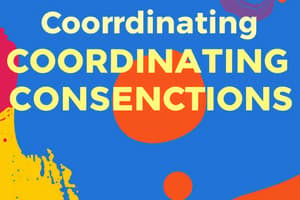Podcast
Questions and Answers
Which sentence correctly uses the coordinating conjunction 'nor'?
Which sentence correctly uses the coordinating conjunction 'nor'?
- He didn’t study, nor he passed the exam.
- She likes pizza, nor does she enjoy pasta.
- I wanted coffee, nor did I want tea.
- He doesn’t like coffee, nor does he enjoy tea. (correct)
Identify the sentence that uses the coordinating conjunction 'yet' correctly.
Identify the sentence that uses the coordinating conjunction 'yet' correctly.
- She sings well yet she dances better.
- I wanted to eat dessert yet I was too full.
- It was cold outside, yet we decided to go for a hike. (correct)
- He likes to run, yet he goes to the gym.
In which sentence is 'but' used incorrectly?
In which sentence is 'but' used incorrectly?
- I wanted to go for a walk but started to rain. (correct)
- She loves swimming but dislikes running.
- He left early, but he missed the train.
- I wanted to go hiking, but it was raining.
Which example shows the correct use of the coordinating conjunction 'for'?
Which example shows the correct use of the coordinating conjunction 'for'?
Select the sentence that uses 'so' correctly.
Select the sentence that uses 'so' correctly.
Study Notes
Coordinating Conjunctions: Examples in Sentences
-
Definition: Coordinating conjunctions connect words, phrases, or clauses that are of equal grammatical rank.
-
Common Coordinating Conjunctions:
- For
- And
- Nor
- But
- Or
- Yet
- So
Examples in Sentences
-
For:
- I went to the store, for I needed some milk.
-
And:
- She likes to read novels, and she enjoys writing poetry.
-
Nor:
- He doesn’t like coffee, nor does he enjoy tea.
-
But:
- I wanted to go for a walk, but it started to rain.
-
Or:
- Would you prefer tea, or would you like coffee?
-
Yet:
- It was cold outside, yet we decided to go for a hike.
-
So:
- They were tired, so they went to bed early.
Additional Notes
-
Punctuation:
- Use a comma before the coordinating conjunction when connecting two independent clauses.
- No comma is needed when connecting single words or phrases.
-
Function in a Sentence:
- Coordinating conjunctions can indicate contrast, choice, addition, or cause-and-effect relationships.
-
Example of Mixed Use:
- I wanted to buy a dress, but it was too expensive, so I chose a simpler outfit instead.
Coordinating Conjunctions Overview
- Coordinating conjunctions join words, phrases, or clauses of equal grammatical rank.
- Commonly used coordinating conjunctions: for, and, nor, but, or, yet, so.
Examples of Coordinating Conjunctions in Sentences
- For: Indicates reason (e.g., "I went to the store, for I needed some milk").
- And: Connects similar ideas (e.g., "She likes to read novels, and she enjoys writing poetry").
- Nor: Presents a negative alternative (e.g., "He doesn’t like coffee, nor does he enjoy tea").
- But: Shows contrast (e.g., "I wanted to go for a walk, but it started to rain").
- Or: Offers a choice (e.g., "Would you prefer tea, or would you like coffee?").
- Yet: Highlights unexpected contrast (e.g., "It was cold outside, yet we decided to go for a hike").
- So: Indicates a consequence (e.g., "They were tired, so they went to bed early").
Additional Notes on Usage
- Punctuation: A comma is required before a coordinating conjunction when connecting two independent clauses.
- No comma is necessary when linking single words or phrases.
- Functionality: Coordinating conjunctions signify contrast, choice, additional information, or cause-and-effect relationships.
- Mixed Usage Example: Demonstrates versatility (e.g., "I wanted to buy a dress, but it was too expensive, so I chose a simpler outfit instead").
Studying That Suits You
Use AI to generate personalized quizzes and flashcards to suit your learning preferences.
Description
Test your knowledge of coordinating conjunctions with this quiz. Examine common examples in sentences and learn how to correctly punctuate them. Ideal for those looking to improve their grammar skills.




